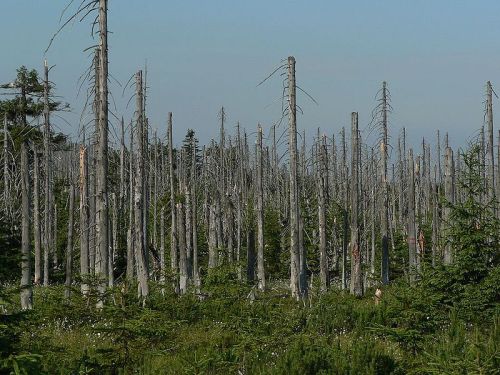
Acid rain is hugely destructive to stone monuments. Photo source: Wkimedia Commons.
Today, something I didn’t know much about (luckily not a huge problem in little old NZ), but I was interested to learn more.
Read on if you too are curious about acid rain, what it really does, and what can be done about it.
What is acid rain?
Acid rain is a mixture of wet (rain fog and snow) and dry (dust and smoke) materials, which contains above average amounts of nitric and sulfuric acid.
These acids form in the atmosphere when emissions of sulfur dioxide (SO2) and nitrogen oxides (NOx) react with water and oxygen.
What causes acid rain?
There are natural emitters of the chemicals released, such as rotting vegetation and volcanic eruptions, however most of it can be attributed to anthropogenic (manmade) activities.
The biggest contributor to atmospheric SO2 and NOx is fossil fuel combustion. Countries that produce energy by burning coal (such as China and the U.S) have elevated atmospheric SO2 and NOx. As measures have been taken to decrease this, vehicle emissions are making up a greater percentage of acid rain producing emissions.
What does it do?
The most harmful effect of acid rain is its impact on our waterways. Prolonged and persistent acid rain can change the pH of water from a healthy 6-7 to an acidic 5-6.
Acidic runoff releases aluminum from the soil, increasing toxic runoff into waterways, which is harmful to aquatic ecosystems. When pH falls to 5, many fish eggs are unable to hatch, and the population may decline. At a pH lower than 5, adult fish may die.
Acid rain can also be harmful to terrestrial ecosystems. It can damage forests, and the released aluminum in the soil retards water and nutrient uptake by plants. The lack of nutrients can kill leaves, and increases the trees vulnerability to other harmful processes, such as climate extremes.
It is not only the natural world that acid rain harms. Acid rain can erode paint on cars, and dissolve limestone and marble buildings.
The cost to paint a car using acid resistant paint is $5 higher per car than to paint it using non acid resistant paint. In the U.S this adds up to $61 million per year.
On the bright side, there is no direct adverse effect on humans who are exposed to acid rain.
However, the particles of pollutant in the atmosphere that cause acid rain do have a negative impact peoples lungs, and are related to asthma, bronchitis and emphysema.
There may be a positive side effect of acid rain. Researchers have found that acid rain may reduce the amount of methane (a powerful green house gas) produced by wetlands. This is due to competition between bacteria that live in the wetlands. Acid rain boosts the number of the bacteria which thrive on sulfur, which in turn reduces the number of methane producing bacteria, therefore methane emissions.
Acid rain in China

After withstanding the elements for 1000 years, the Leshan Giant Buddha in China is being slowly destroyed by acid rain. Photo source: Wikimedia Commons.
China is the third largest acid rain region (behind Europe and the U.S), and burns over 3 billion tons of coal per annum.
In 2011 it was reported that 258 Chinese cities experienced acid rain according to official statistics.
The Leshan Giant Buddha, is an ancient statue carved from a cliff, is 1000 years old, and the largest Buddha in the world (standing 71 meters high). Sadly, the Buddha has been badly affected by the acid rain. Its nose is turning black, it hair is eroding, and its reddish body is becoming a charred grey colour.
However, there is hope.
Between 2006 and 2009 Chinas SO2 emissions decreased by 13%, despite construction of new coal fired power plants. This may be explained by the closure if hundreds of old, small inefficient coal fired power plants by the government, and the introduction of a requirement for air filters and monitoring of emissions,
What can be done?
The best way of limiting the effects of acid rain is by limiting the causes of it. Reducing burning of fossil fuels, using less energy, or finding alternative energy sources are the most effective ways to combat acid rain.
In October 2007, American Electric Power (AEP) settled a lawsuit for failing to take the necessary steps to mitigate the impact of acid rain, brought against it by the Environmental Protection Agency (EPA).
Despite denying any wrongdoing, AEP settled the case by promising to spend $1.6 billion to upgrade its coal powered plants.
With continuing legal challenges, public pressure, and sound legislation, such as the EPA’s Acid Rain Program, we can hope there is an end in sight for acid rain.
Furthermore, as coal fired plants and vehicle emissions also contribute to the enhanced greenhouse effect (global warming action on one can only have positive effects on the other, effectively killing two very environmentally destructive birds with one stone.
Sources:


